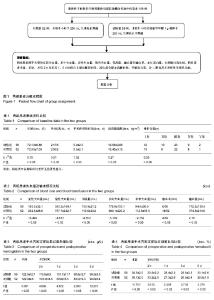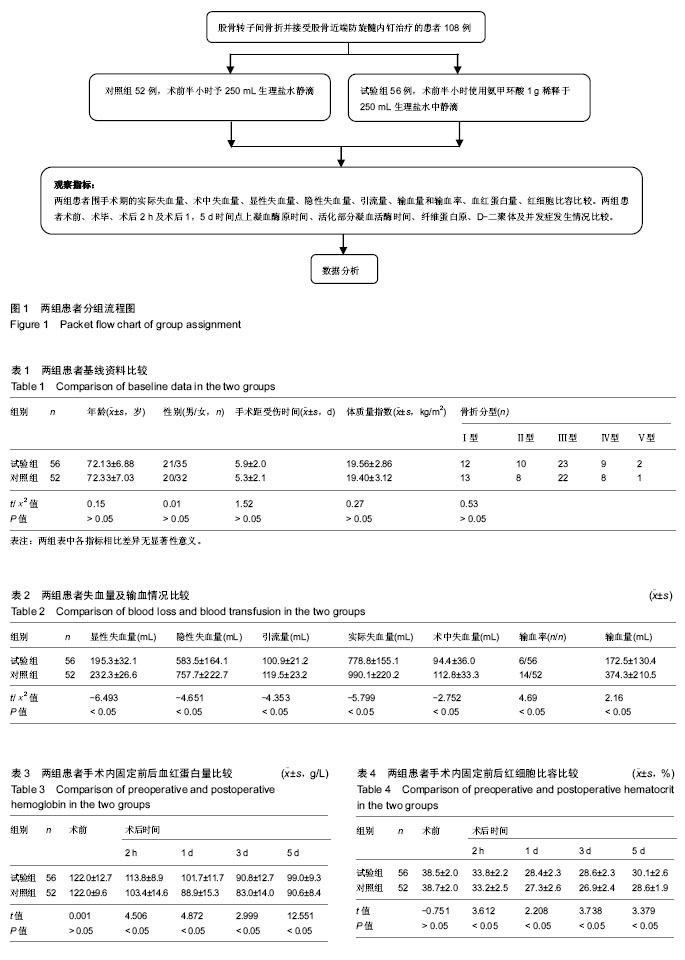| [1] Butler M, Forte ML, Joglekar SB, et al. Evidence summary: systematic review of surgical treatments for geriatric hip fractures. J Bone Joint Surg Am. 2011;93(12):1104-1115.[2] Scaglione M, Fabbri L, Di R F, et al. The second hip fracture in osteoporotic patients: not only an orthopaedic matter. Clin Cases Miner Bone Metab. 2013;10(2):124-128.[3] 史庆轩,胡宏伟,宁廷民,等.PFNA治疗高龄股骨粗隆间骨折隐性失血的发生机制及影响因素初步分析[J].中国矫形外科杂志, 2014,22(14):1262-1265.[4] 李宝玲.老年人血常规参考值范围及老年贫血的调查研究[M].北京:中国人民解放军医学院,2015.[5] Chen JY, Chin PL, Moo IH, et al. Intravenous versus intra-articular tranexamic acid in total knee arthroplasty: a double-blinded randomised controlled noninferiority trial. Knee. 2016;23(1):152-156.[6] Martin JG, Cassatt KB, Kincaidcinnamon KA, et al. Topical administration of tranexamic acid in primary total hip and total knee arthroplasty. J Arthrop. 2014;29(5):889-894.[7] 赵清斌,任姜栋,张晓岗,等.氨甲环酸静脉或局部及联合应用初次单侧全髋关节置换:围置换期出血及输血率的比较[J].中国组织工程研究, 2016, 20(4):459-464.[8] Sentilhes L, Lasocki S, Ducloybouthors AS, et al. Tranexamic acid for the prevention and treatment of postpartum haemorrhage. Br J Anaesth. 2015;114(4):576-587.[9] Lei J, Zhang B, Cong Y, et al. Tranexamic acid reduces hidden blood loss in the treatment of intertrochanteric fractures with PFNA: a single-center randomized controlled trial. J Orthop Surg Res. 2017;12(1):124.[10] Tengberg PT, Foss NB, Palm H, et al. Tranexamic acid reduces blood loss in patients with extracapsular fractures of the hip: results of a randomised controlled trial. Bone Joint J. 2016;98-B(6):747-753.[11] 纪振伟,夏力,姚立东,等.氨甲环酸治疗老年转子间骨折髓内固定固定后隐性失血的疗效[J].中国老年学,2015(7):1853-1854.[12] Baruah RK, Borah PJ. Use of tranexamic acid in dynamic hip screw plate fixation for trochanteric fractures. J Orthop Surgery (Hong Kong). 2016;24(3):379-382.[13] 王军,危杰,王满宜.股骨转子间骨折围手术期隐性失血量计算方法的分析[J].中华创伤骨科杂志,2014,16(5):437-440.[14] Nadler SB, Hidalgo JH, Bloch T. Prediction of blood volume in normal human adults. Surgery. 1962;51(2):224.[15] Gross JB. Estimating allowable blood loss: corrected for dilution. Anesthesiology. 1983;58(3):277.[16] 程建,雷会宁,冯仕明,等.PFNA与DHS治疗不稳定型股骨粗隆间骨折的Meta分析[J].重庆医学,2016,45(21):2956-2961.[17] Carulli C, Piacentini F, Paoli T, et al. A comparison of two fixation methods for femoral trochanteric fractures: a new generation intramedullary system vs sliding hip screw. Clin Cases Miner Bone Metab. 2017;14(1):40-47.[18] 邹明,柏广富,张焱,等.三种不同内植物固定治疗老年股骨转子间骨折[J].中国组织工程研究,2012,16(30):5696-5700.[19] 曾晶山,蔡贤华,李稳,等.隐性失血量对老年股骨转子间骨折固定后临床疗效影响的分析[J].中国矫形外科杂志,2016,24(2):106-109.[20] Yang X, Wu Q, Wang X. Investigation of perioperative hidden blood loss of unstable intertrochanteric fracture in the elderly treated with different intramedullary fixations. Injury. 2017;48(8):1848-1852.[21] Sehat K, Evans RJ. Hidden blood loss following hip and knee arthroplasty. Correct management of blood loss should take hidden loss into account. J Bone Joint Surg Br. 2004;86(4):561.[22] Foss NB, Kehlet H. Hidden blood loss after surgery for hip fracture. J Bone Joint Surg Br. 2006;88(8):1053.[23] Pattison E, Protheroe K, Pringle RM, et al. Reduction in haemoglobin after knee joint surgery. Ann Rheum Dis. 1973;32(6):582-584.[24] 黄伟,许力月,邵森垚,等.髋部骨折对老年患者凝血功能的影响[J].北京大学学报(医学版)医学版,2013,45(5):742-744.[25] 张波,庞清江,章海均,等.全膝关节置换固定后隐性失血的研究进展[J].中国骨伤,2012,25(9):101-103.[26] 王超,张璐,张龙,等.氨甲环酸用于脊柱手术的有效性和安全性Meta分析[J].中华骨与关节外科杂志,2016,9(6):498-503.[27] 寿晓梅,余柳霖.氨甲环酸对成人先天性心脏病手术的血液保护作用[J].中国胸心血管外科临床杂志,2016,23(12):1139-1141.[28] Amer K, Rehman S, Haydel C. Efficacy and safety of tranexamic acid in orthopedic fracture surgery: a meta analysis and systematic literature review. J Orthop Trauma. 2017. doi: 10.1097/BOT.0000000000000919.[29] Pei Z, He J, Fang Y, et al. Efficacy and safety of intravenous tranexamic acid administration in patients undergoing hip fracture surgery for hemostasis: a meta-analysis. Medicine. 2017;96(21):e6940.[30] 朱云森,江敞,李俊.氨甲环酸对老年股骨转子间骨折髓内固定术围手术期隐性失血的影响[J].中医正骨,2015(6):16-18.[31] 胡维信,苏振炎,张益宏.氨甲环酸联合低分子肝素在老年股骨转子间骨折围手术期的应用[J].临床骨科杂志,2017,20(2):185-187.[32] Zhang P, He J, Fang Y, et al. Efficacy and safety of intravenous tranexamic acid administration in patients undergoing hip fracture surgery for hemostasis: a meta-analysis. Medicine (Baltimore). 2017;96(21):e6940.[33] 王小军,陈永华,程昊,等.氨甲环酸应用于股骨转子间骨折的有效性和安全性分析[J].浙江医学,2017,39(16):1373-1375.[34] Bishop GE, Garner MR, Warner SJ, et al. Tranexamic acid in hip fracture patients: a protocol for a randomised, placebo controlled trial on the efficacy of tranexamic acid in reducing blood loss in hip fracture patients. Bmj Open. 2016;6(6):e010676.[35] 林锦秀,孙东升,郑潇,等.局部应用氨甲环酸干预股骨粗隆间骨折PFNA内固定固定后隐性失血的临床分析[J].山东大学学报(医学版), 2016,54(1):67-70.[36] Virani SR, Dahapute AA, Panda I. Role of local infiltration of tranexamic acid in reducing blood loss in peritrochanteric fracture surgery in the elderly population. Malays Orthop J. 2016;10(3):26-30.[37] Mohib Y, Rashid RH, Ali M, et al. Does tranexamic acid reduce blood transfusion following surgery for inter-trochanteric fracture? A randomized control trial. J Pak Med Assoc. 2015;65(11 Suppl 3): S17-S20.[38] Mansukhani SA, Tuteja SV, Kasodekar VB. A comparative study of the dynamic hip screw, the cemented bipolar hemiarthroplasty and the proximal femoral nail for the treatment of unstable intertrochanteric fractures. J Clin Diagn Res. 2017;11(4):RC14-RC19.[39] 邵进,杨铁毅,王治,等.动力髋螺钉、股骨近端抗旋髓内钉与联合加压交锁髓内钉系统修复股骨转子间骨折(英文)[J].中国组织工程研究, 2015, 19(22):3543-3549. |



